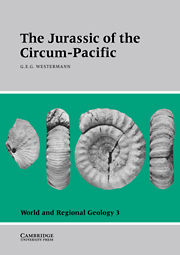Book contents
- Frontmatter
- Contents
- List of contributors
- Preface
- Acknowledgments
- Introduction
- Part I Time scales
- Part II Circum-Pacific base map
- Part III Regional geology and stratigraphy
- 4 Western Canada and United States
- 5 Meso-America
- 6 Western South America and Antarctica
- 7 Australasia
- 8 Indonesia and Papua New Guinea
- 9 Southeast Asia and Japan
- 10 Eastern China
- 11 Eastern Russia
- Part IV Biochronology
- Part V Biogeography
- Part VI Climatology and oceanography
- Appendix: Biochronology and atlas with index and guide fossils
- General Index
- Index of Guide- and Indexfossils
5 - Meso-America
Published online by Cambridge University Press: 04 August 2010
- Frontmatter
- Contents
- List of contributors
- Preface
- Acknowledgments
- Introduction
- Part I Time scales
- Part II Circum-Pacific base map
- Part III Regional geology and stratigraphy
- 4 Western Canada and United States
- 5 Meso-America
- 6 Western South America and Antarctica
- 7 Australasia
- 8 Indonesia and Papua New Guinea
- 9 Southeast Asia and Japan
- 10 Eastern China
- 11 Eastern Russia
- Part IV Biochronology
- Part V Biogeography
- Part VI Climatology and oceanography
- Appendix: Biochronology and atlas with index and guide fossils
- General Index
- Index of Guide- and Indexfossils
Summary
WESTERN MEXICO
Introduction
Rocks of Jurassic age are known from three main areas along the Pacific margin of Western Mexico: the Baja California Peninsula; the state of Sonora, west of the Neogene volcanics of the Sierra Madre Occidental; and the states of Guerrero and Oaxaca (Figure 5.1). These Jurassic sequences were formed, in one way or another, west of the North American plate, within the Pacific domain. Other Jurassic sequences of Mexico, from the state of Chihuahua in northern Mexico to the southernmost part of the country, northeast of the Chiapas Massif, are genetically related to the early development of the Gulf of Mexico Basin (Salvador 1987).
The sites and manners of formation of the Jurassic rock sequences of western Mexico are subjects of some controversy. The Pacific margin of Mexico is believed by some authors (e.g., Coney, Jones, and Monger 1980; Campa and Coney 1983; Howell et al. 1983; Gastil 1985; Kimbrough 1985; Moore 1985) to be composed of a collage of what have been called “suspect terranes” or “tectonostratigraphic terranes” – allochthonous crustal blocks that are assumed to have collided and accreted to the North American craton mostly during the Mesozoic and early Cenozoic, after having, in some cases, traveled long distances.
- Type
- Chapter
- Information
- The Jurassic of the Circum-Pacific , pp. 93 - 121Publisher: Cambridge University PressPrint publication year: 1993
- 2
- Cited by

